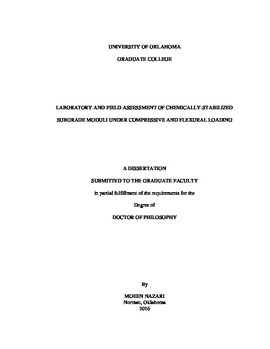| dc.description.abstract | The design and quality of the chemically-stabilized subgrade (CSS) layer have a vital role in the overall performance of the asphalt pavement. Uniform compaction of the CSS layer to the desired level can assure the amenability to design considerations. In the field, the last occasion of increasing the CSS quality is roller compaction. In the mechanistic-empirical pavement design guide (M-EPDG), the response of subgrade soils is represented in terms of resilient modulus (Mr). However, using chemical stabilizers such as cement kiln dust (CKD) and lime, makes the flexural behavior of subgrades more dominant, compared to untreated subgrades. Consequently, it is important to consider the flexural behavior of a CSS layer in pavement design. In this study, the application of the Intelligent Compaction Analyzer (ICA), developed at the University of Oklahoma, in quality control and quality improvement of CSS layers is addressed. Also, the flexural properties of chemically-stabilized soil and influence of different parameters, such as type and amount of the additive, tensile strain at failure and flexural modulus, on the fatigue life of the CSS is evaluated. The CSS layer in four different pavement construction projects were compacted using ICA-equipped smooth drum rollers. For each project, the CSS moduli through the entire construction stretch were estimated in real-time and compared with the laboratory Mr test results. The results showed that the ICA was able to estimate the modulus of the stabilized subgrade with accuracy suitable for the control of compaction quality. Project results demonstrate that the ICA was helpful in identifying and remediating the under-compacted regions in stabilized subgrades. It was also found that the average subgrade modulus and overall uniformity of compaction could be improved with the use of the ICA. Additionally, to evaluate the flexural properties of the CSS, specimens of a lean clay soil mixed with different types (CKD and lime) and amounts of additive, were prepared. Modulus of rupture (MoR), flexural modulus and four point flexural fatigue (FPFF) tests on beam specimens were conducted. The laboratory results indicated that the flexural strength and flexural modulus of the chemically-stabilized soil increased due to an increase in the amount of additive. The increase was more significant for CKD-stabilized soil compared to lime-stabilized soil. Also, for a specific additive type, mixtures with the highest strain at failure possess the highest fatigue life. The results of MoR and FPFF tests were used to develop a fatigue life prediction model based on flexural properties, i.e., flexural modulus, tensile strain at failure and induced tensile strain at the bottom of the chemically-stabilized beam. The suggested model could predict the fatigue life of the tested mixtures and the mixtures reported in the literature with a good accuracy compared to the proposed models in the previous studies. Another important aspect of this study was to study the effect of considering the flexural properties and fatigue life of CSS layer on the designed hot mix asphalt (HMA) layer thickness in a semi-rigid pavement using M-EPDG method. The results showed that for the CSS materials with relatively low fatigue lives, the fatigue cracking of the CSS layer was the most critical distress to be considered in designing of the pavement’s structure. By substituting the CSS resilient modulus with the properly determined flexural modulus in the mechanistic-empirical design procedure, the designed HMA thickness, and consequently, the construction cost could significantly decrease. | en_US |
